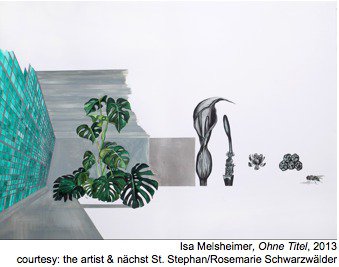Isa Melsheimer
dal 19/3/2013 al 26/4/2013
Segnalato da
19/3/2013
Isa Melsheimer
Galerie Rosemarie Schwarzwaelder, Wien
Plant Hunters. In her installations sculptural, textile works, gouaches, the artist not only creates architectural frames of reference, she also explores issues of housing and the organization of our immediate environment.

Galerie nächst St. Stephan Rosemarie Schwarzwälder is pleased to present the third solo exhibition from Berlin based artist Isa Melsheimer.
In her installations, sculptural and textile works, and gouaches, Isa Melsheimer not only creates architectural frames of reference, she also explores issues of housing, the organization of our immediate environment, and aspects of urban planning. In the process, she singles out individual formal elements and inspects their cultural codes. Her most recent sculptures display a linkage between concrete as a material and vegetation. In Plant Hunters, Melsheimer takes us on an expedition to the world of plants, in particular botanical gardens. She investigates the idea behind these gardens, their history, and the precarious implications of campaigns of conquest and colonialism associated with them.
After its emergence in the 17th century, the occupation of plant hunter became a respectable profession in the 19th century. Plant hunters were natural scientists and traveling researchers, and they accompanied world explorers on their journeys in service of the colonial powers. Transporting plants from America, Asia, Australia, and Africa by sea was costly and ineffective, and only a few of the collected plants ever reached their destination alive. In 1835, the British physician Nathaniel Ward invented a device that led to a decisive turn in the transport of this valuable commodity. His new sealed glass cases filled with wet soil meant that seeds and germ buds were finally able to survive the long voyage by sea that sometimes lasted several weeks.
In the first room of the exhibition, Isa Melsheimer’s sculptures revolve around the idea behind these devices known as Wardian cases. As a plant hunter, she collected specimens in glass cubes, including several plants from the botanical garden in Lisbon, a tree tumbo (Welwitschia mirabilis) from the Namibia section of the botanical garden in Dahlem in Berlin, and a Chinese fan palm (called a “Maria Theresa” palm tree) from Schönbrunn.
The room is divided by pieces of fabric with embroidered motifs, including a funerary relief of the Egyptian Queen Hatshepsut, depicting her return from the conquered land of Punt on a ship, together with a load of plants. Another motif depicts the munity on the Bounty, which may have broken out because drinking water was given to the breadfruit trees on board rather than the sailors. Alongside these pieces, Isa Melsheimer’s gouaches combine studies of plants with architectural elements.
In the adjoining room, the consequences of the so-called Wardian turn can be observed. Due to globalized capitalism, the “green gold” has been sentenced to a sad existence in countless discount stores. Once expensive orchids and other exotic plants now wilt away by the thousands in large sales at reduced prices. Among the plants, Melsheimer has placed budgie parakeets. These small, economically priced descendants of the once so valuable parakeets from grand aviaries are now sold in large quantities to middle-class households. In defiance of this situation, the expensive porcelain figures remind us of valuable figurines in display cases.
The windows of the gallery are coated with a milky fluid, creating a greenhouse atmosphere. Isa Melsheimer’s exhibition is a self-contained biotope with no visible access to the outside world.
Isa Melsheimer (born 1968 in Neuss) lives and works in Berlin. Recent exhibition (selection): Kunstmuseum Mühlheim an der Ruhr (2013); Santa Monica Museum of Art, Santa Monica, CA; Palais de Tokyo, Paris; Neues Museum, Nürnberg (all 2012); MUDAM Luxembourg (2011); Kunsthaus Langenthal; Carré d’art – musée d’art contemporain, Nîmes; Temporäre Kunsthalle Berlin (2010).
In 2012, Isa Melsheimer was Artist in Residence at the Goethe-Institut Lisbon and is currently a fellow at the German Academy, Rome Villa Massimo.
Press office: I David Ulrichs I david@david-ulrichs.com I +49 (0)176 5033 0135 I www.david-ulrichs.com I
Opening: Wednesday, 20 March, 7pm
Galerie Rosemarie Schwarzwaelder
Grunangergasse 1, Wien
Hours: Tue - Fri: 11am - 6pm; Sat: 11am - 4pm
Free Admission



